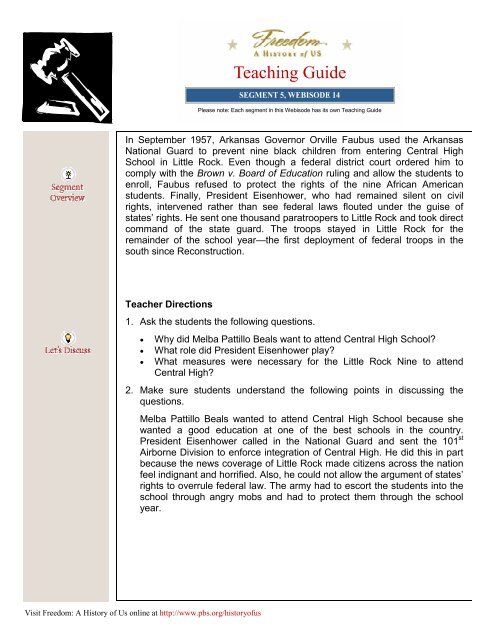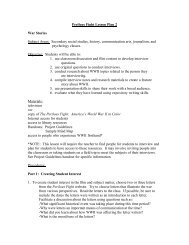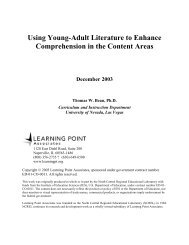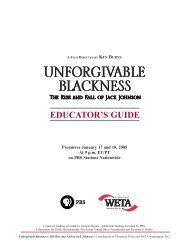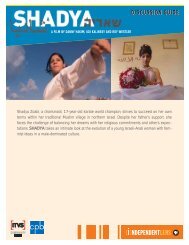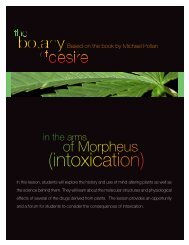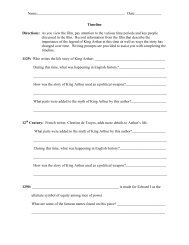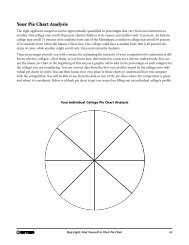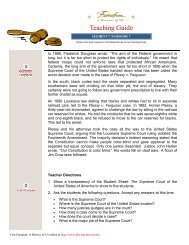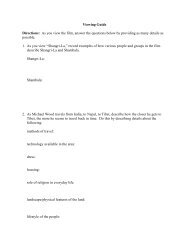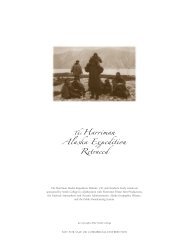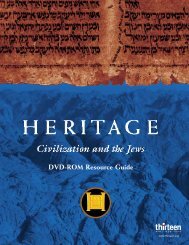Segment 14-5.pub - PBS
Segment 14-5.pub - PBS
Segment 14-5.pub - PBS
You also want an ePaper? Increase the reach of your titles
YUMPU automatically turns print PDFs into web optimized ePapers that Google loves.
Please note: Each segment in this Webisode has its own Teaching Guide<br />
In September 1957, Arkansas Governor Orville Faubus used the Arkansas<br />
National Guard to prevent nine black children from entering Central High<br />
School in Little Rock. Even though a federal district court ordered him to<br />
comply with the Brown v. Board of Education ruling and allow the students to<br />
enroll, Faubus refused to protect the rights of the nine African American<br />
students. Finally, President Eisenhower, who had remained silent on civil<br />
rights, intervened rather than see federal laws flouted under the guise of<br />
states’ rights. He sent one thousand paratroopers to Little Rock and took direct<br />
command of the state guard. The troops stayed in Little Rock for the<br />
remainder of the school year—the first deployment of federal troops in the<br />
south since Reconstruction.<br />
Teacher Directions<br />
1. Ask the students the following questions.<br />
• Why did Melba Pattillo Beals want to attend Central High School?<br />
• What role did President Eisenhower play?<br />
• What measures were necessary for the Little Rock Nine to attend<br />
Central High?<br />
2. Make sure students understand the following points in discussing the<br />
questions.<br />
Melba Pattillo Beals wanted to attend Central High School because she<br />
wanted a good education at one of the best schools in the country.<br />
President Eisenhower called in the National Guard and sent the 101 st<br />
Airborne Division to enforce integration of Central High. He did this in part<br />
because the news coverage of Little Rock made citizens across the nation<br />
feel indignant and horrified. Also, he could not allow the argument of states’<br />
rights to overrule federal law. The army had to escort the students into the<br />
school through angry mobs and had to protect them through the school<br />
year.<br />
Visit Freedom: A History of Us online at http://www.pbs.org/historyofus
Page 2 of 4<br />
<strong>Segment</strong> 5, Webisode <strong>14</strong><br />
Teacher Directions<br />
1. Use the website: http://teacher.scholastic.com to read an interview with<br />
Melba Patillo Beals. Tell the students that in 1998 and 1999 Melba Pattillo<br />
Beals answered questions from students about her experiences at Central<br />
High in 1957. Read the questions and Ms. Beale’s responses.<br />
2. Discuss the following questions with students.<br />
• What gave Melba Pattillo Beals courage in the face of real physical<br />
danger and verbal attack?<br />
• How does her attitude agree with the nonviolent spirit that Dr. King<br />
supported for the civil rights movement?<br />
Teacher Directions<br />
1. Show students photographs of the crowds outside Central High School in<br />
Little Rock in September 1957. A good source is The Integration of Little<br />
Rock Central High School @ http://www.journalism.indiana.edu/gallery/<br />
faculty/counts/integration.html<br />
2. Discuss with the students the extraordinary courage of the nine African<br />
American students of Little Rock.<br />
3. Students write a brief journal entry answering the question: How do you<br />
think you would act in a similar situation?<br />
Teacher Directions<br />
1. Inform the students that the National Association for the Advancement of<br />
Colored People (N.A.A.C.P.) called for volunteers to integrate Central High.<br />
They hoped to get one hundred African American students. They got only<br />
nine volunteers.<br />
2. Students research one of the Little Rock Nine to discover what happened<br />
to them and what they are doing today. In addition to Melba Pattillo Beals,<br />
they include Elizabeth Eckford, Jefferson Thomas, Terrence Roberts,<br />
Carlotta Walls Lanier, Gloria Ray Karlmark, Thelma Mothershed-Wair,<br />
Minnijean Brown Trickey, and Ernest Green.<br />
3. Some good internet sources include The Little Rock Nine @ http://<br />
www.centralhigh57.org/The_Little_Rock_Nine.html, and CNN @ http://<br />
www.cnn.com/US/9911/09/little.rock.nine.02/.<br />
4. Students share their findings with the entire class.<br />
5. The students discuss the following questions.<br />
Visit Freedom: A History of Us online at http://www.pbs.org/historyofus
Page 3 of 4<br />
<strong>Segment</strong> 5, Webisode <strong>14</strong><br />
Moving Toward Freedom,<br />
Continued.<br />
• What occupations did the Little Rock Nine enter?<br />
• Could they have pursued these careers without a good education?<br />
• Was Melba Pattillo Beals correct that a good education would give her<br />
and her fellow African American students a better opportunity to<br />
succeed in life?<br />
• How did education help the Little Rock Nine and all the African<br />
Americans who benefited from integrated schools to move toward<br />
freedom?<br />
Note to the Teacher: If Internet access is not available, students may use<br />
other sources or share with them the following information.<br />
Melba Pattillo Beals has written two books: White is a State of Mind tells<br />
about her experiences living in a white family in California in 1959, and<br />
Warriors Don't Cry about the civil rights movement and her experience in<br />
Little Rock. She has also worked as a broadcast journalist for NBC and a<br />
journalist for People magazine. She lives in Sausalito, California.<br />
Elizabeth Eckford had a career in the United States Army that included<br />
work as a journalist. She now works part-time as a social worker and is the<br />
mother of two sons. In 1974, she returned to Little Rock to live in the home<br />
in which she grew up.<br />
Jefferson Thomas graduated from Central High in 1960. He became an<br />
accountant and works with the United States Department of Defense. He<br />
lives in Anaheim, California.<br />
Terrence Roberts moved with his family to Los Angeles in 1958, and he<br />
finished high school there. He earned a Ph.D. and now teaches at the<br />
University of California at Los Angeles and Antioch College. Dr. Roberts is<br />
also a clinical psychologist.<br />
Carlotta Walls Lanier graduated from Central High in 1960 and from<br />
Michigan State University. She now works in real estate and lives in<br />
Englewood, Colorado.<br />
Gloria Ray Karlmark graduated from Illinois Technical College and earned<br />
a post-graduate degree in Stockholm, Sweden. Her career included<br />
publishing successful magazines in thirty-nine countries and working as a<br />
computer science writer. In her retirement she divides her time between<br />
homes in Amsterdam and Sweden.<br />
Thelma Mothershed-Wair after graduating from college had a teaching<br />
career. She now volunteers in a program for abused women in Belleville,<br />
Illinois, where she lives.<br />
Minnijean Brown Trickey fought back at her tormenters. When she<br />
dumped a bowl of chili on the head of a student in the school cafeteria, she<br />
was expelled in February 1958.<br />
During the Vietnam War protests, she moved to Canada with her husband.<br />
She is a writer and social worker in Ontario.<br />
Visit Freedom: A History of Us online at http://www.pbs.org/historyofus
Page 4 of 4<br />
<strong>Segment</strong> 5, Webisode <strong>14</strong><br />
Moving Toward Freedom,<br />
Continued.<br />
Ernest Green became the first black student to graduate from Central High<br />
in 1958. After graduating from Michigan State University, he served as<br />
Assistant Secretary of Housing and Urban Affairs under President Jimmy<br />
Carter. He currently is a managing partner and vice president of Lehman<br />
Brothers in Washington, D.C.<br />
Teacher Directions<br />
Use the following activities with your students.<br />
Language Arts — Students read books by and about the Little Rock Nine.<br />
Some possibilities include “The Little Rock Nine: Ernest Green” from<br />
Freedom's Children: Young Civil Rights Activists Tell Their Own Stories by<br />
Ellen Levine (Avon Books); The Girl on the Outside by Mildred Pitts Walter<br />
(Scholastic); Witnesses To Freedom: Young People Who Fought for Civil<br />
Rights by Belinda Rochelle (Lodestar Books); Cracking the Wall: The Story of<br />
the Little Rock Nine by Eileen Lucas (Carolrhoda Books).<br />
Local History — Students interview someone who remembers the pivotal<br />
events of the civil rights movement and write a summary of that person’s<br />
experiences. How did the interviewee feel during this time? How did the<br />
movement affect his or her daily life? Was he or she involved in the movement<br />
in any way?<br />
Art — Students examine the art of Jasper Johns, who pioneered Pop Art in<br />
the 1950s. Students create their own work in the style of Johns.<br />
Technology/Library — Students use the Internet to research the life of Carter<br />
G. Woodson, the founder of Black History Month.<br />
Visual Arts — Students view and discuss the Norman Rockwell print<br />
depicting the integration of Central Rock High School in Little Rock. What<br />
message is the artist communicating? How does he make his point?<br />
Visit Freedom: A History of Us online at http://www.pbs.org/historyofus


